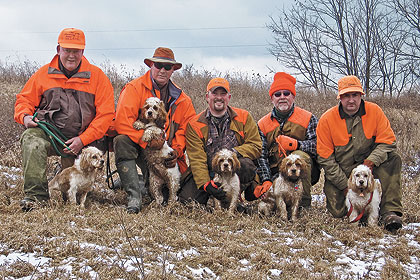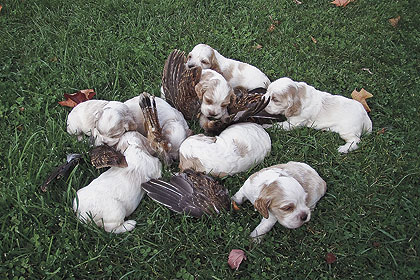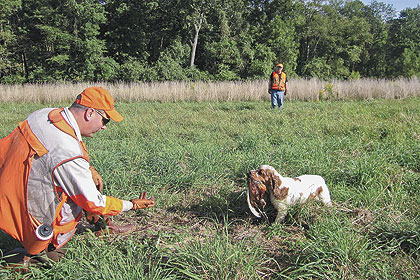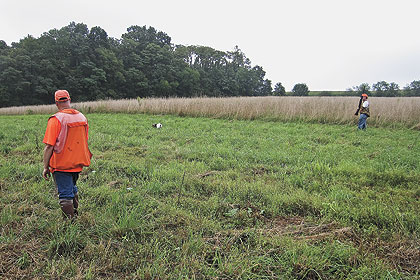€¦And perhaps a bit of group therapy, as well!
By John McGonigle
The three-and-a-half month old pup chased the chukar down, grasped it in its mouth and returned the bird to its master as if it was an experienced five-year-old gun dog.
 In the photo, left to right, are Bob Mitchell and Nutmeg; Rich Palmer and Amber; Kurt Shearer and Logan; Bob Boyd and Bailey; and Andy Palmer and Ruger. The pups were about five months old here and had begun retrieving birds that had been shot over them. |
I am not sure how Bob Mitchell's young adult daughter feels about this, but recently he told me he only got another gun dog because his daughter left the familial nest. While Mitchell misses his daughter, he is certainly thrilled with the addition of another female to his home, his American cocker spaniel pup, Nutmeg.
Mitchell is the editor of Pennsylvania Game News, the Pennsylvania Game Commission's official magazine, as well as a friend of nearly two decades. He taught college-level wildlife courses prior to joining the game commission. He is an avid hunter, has a fondness for accurate .22 rifles and previously owned and hunted a Labrador retriever.
Mitchell and some friends added a twist to training their pups as a group by enlisting the aid of Rich Palmer, a friend, co-worker to three of them€¦and an expert dog trainer.
Palmer arranged a breeding using his sire, Ranger, that allowed him to keep most of the puppies for his friends, while keeping one female for himself. Palmer agreed to teach the group how to get the most from their pups by establishing a long-range group training program, gratis.
Palmer and his cockers appeared in this space previously. The short version is that Palmer was an expert military canine trainer who later trained and commanded other dog trainer/handlers. His experience covered both scent dogs and attack dogs. Additionally, Palmer is a third generation breeder, trainer and hunter of American cocker spaniels who provides his dogs with far more bird hunting time annually than most hunters today.
Palmer is now head of law enforcement for the Pennsylvania Game Commission.
 Here the pups are about five weeks old and being introduced to bird scent. |
Mitchell explained that five friends, including Palmer, have pups from Palmer's litter: Palmer and Mitchell have females; Andy Palmer, Rich's cousin, has a male; Kurt Schearer and Bob Boyd also have males.
"Bob Boyd has owned and hunted English springer spaniels for about two decades," said Mitchell. Boyd is PGC Assistant Director of Game Management and Schearer is a PGC surveyor.
In July, 2009, the pups were nearly two years old, all with early training and bird contact. Palmer has some interesting ideas on starting young dogs early. Other than last summer, monthly field training sessions using birds were held with three to five group members and their pups participating.
Rich Palmer is the acknowledged expert and group leader, and he advises group members about raising and training their young cockers. He organized and ran the group training sessions.
"We did our own obedience training as time permitted," said Mitchell. "Each of our dogs showed individual progress related to control and bird work." Mitchell readily admitted to spending only a moderate amount of time on obedience work. (Cockers tend not to like repetitive drills.) "Nutmeg's responses to commands aren't instant, but most times she reacts positively after a moment's hesitation," said Mitchell.
Nutmeg is a smart pup, as are most of the others. Mitchell said her housebreaking was very easy, even though she would have nothing to do with crate training. "She came around very quickly and earned entry to the entire house," said Mitchell. "She hasn't had any accidents, and has not caused any of the normal damage one hears about from chewing puppies, etc."
 Amber retrieves to Rich Palmer. |
Chukars were generally used to work with the pups because they are readily available and legal to use without red tape or permits. Chukars provide good scent, and they also taste good at the end of the day, especially when breasted out and cooked on a grill. Pigeons were also used sometimes.
"The first group field session was when the pups were three and a half months old," said Mitchell. "We had had our pups for two months by then."
After the pups romped and emptied themselves, the group began working. "Rich lined us up in a field with our pups on lead and tossed a wing-clip chukar a distance from us in a low-cut field," said Mitchell. He said that Palmer had them each bring their pup forward one at a time while the others watched, and they sent each pup after a chukar.
"That went quite well," said Mitchell, "with some pups retrieving better than others. All the pups ran the bird down--some didn't retrieve it right away." He said all the pups did well, with most at least grabbing the bird.
"It was all sight work, with no scenting involved." Pups took turns, with each one chasing and retrieving four wing-clip chukars. What a bunch of happy puppies!
Palmer repeated the drill a month later but added something different -- and important.
Palmer shot a .22 blank gun as each pup neared a chukar, being sure he was not too close to the pursuing pup.
"None of the puppies were bothered by the noise," said Mitchell. "We all watched, handlers and puppies, while one pup at a time chased and retrieved the bird while ignoring the blank gun."
During the second session most of the pups brought the birds to hand, though not all did.
After the initial chase and retrieve of a chukar, Palmer instructed each handler to toss the bird and allow pup to retrieve it. Everything went well, according to Mitchell, with each pup getting an additional two to four retrieves.
"Nutmeg was good at returning the chased bird to hand," said Mitchell, "but didn't do as well with that job when I hand-tossed the bird. I quit tossing it and she continued to perform well after chases.
"We had five young pups working birds and each reacted a little differently; each progressed at his/her own rate," said Mitchell. He said the group helped keep their friend's spirits up if one pup didn't perform as well as the others.
He also explained that as they progressed, the pups' performances improved and retreated, so that basically the pups remained fairly close in ability, though not in every case. "Both verbal and visual encouragement was helpful," Mitchell said.
At six and a half months, and after only two group field sessions, Palmer upped the ante by having the pups find, flush and retrieve planted chukars. This drill was the basic three-man drill used for years by spaniel trainers, with a helper on each side of the owner/handler, who walks down the middle of the field of light cover, with one or two chukars already planted.
 Quartering drills. |
"Palmer stayed right with us, encouraging and helping us keep our pups covering the ground. He definitely added an element of calmness that we appreciated," said Mitchell.
Mitchell reminded me to mention that the cover wasn't too heavy, as the pups were still young and still had limited experience with birds.
"We were really pleased with the flushing and retrieving effort because none of the pups experienced any problems with gunshyness or bird shyness," said Mitchell. He said they also worked on quartering and that having a helper on each "wing" helped establish the proper distance for pup to cover.
"Most of the pups went right to the downed birds and made their retrieves, but as usual, some did better than others," said Mitchell, who pointed out that the females did somewhat better than the males -- at that point in their training, anyway.
Mitchell was very careful to avoid saying anything negative about anyone's pup, but he did explain that two owners had problems that appeared to slow their pup's progress. In both cases it appeared the pups did not get enough time with "dad" during the week and the pups were lagging a bit.
"Really," said Mitchell," all the pups were doing well, but I think at least two just needed more time with their owners. With jobs and families it can be tough spending as much time as you would like with your pup."
On the fourth field session one pup that was lagging behind on retrieving saw the light and has forged ahead wonderfully, according to Mitchell. "It happened by having Rich and the one owner work with the pup alone," said Mitchell. "It was really nice to see the turnaround." He said it is also nice to have everyone rooting for the other guys and their pups.
"For several sessions none of the pups were great at retrieving directly to hand," said Mitchell. "Some pups even ran off with the birds at first." (No surprise there!) Mitchell explained that it did not take long for the pups to bring the bird in, though he admitted that most pups only bring the birds close to the handler.
"One of the guys is upset that his job keeps him away during the week and it's slowing his pup's progress," said Mitchell. "He knows his pup needs more work and wants to do it, but just can't right now.
"We all had bad things happen that we needed to address," Mitchell concluded. "But Rich Palmer was always there to advise us and help us solve our problem.
"Our group training, good pups and an experienced trainer helped us tremendously, and we plan to keep working together when we can. We're all excited about this bird season."






